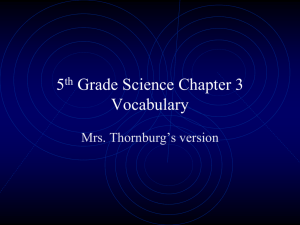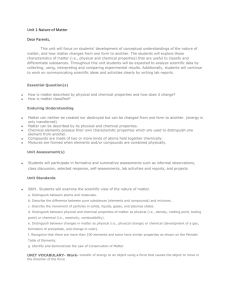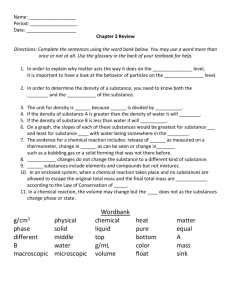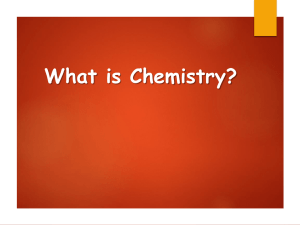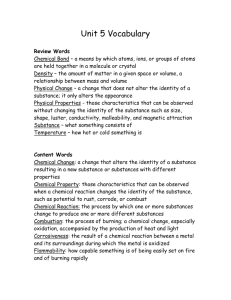matter
advertisement
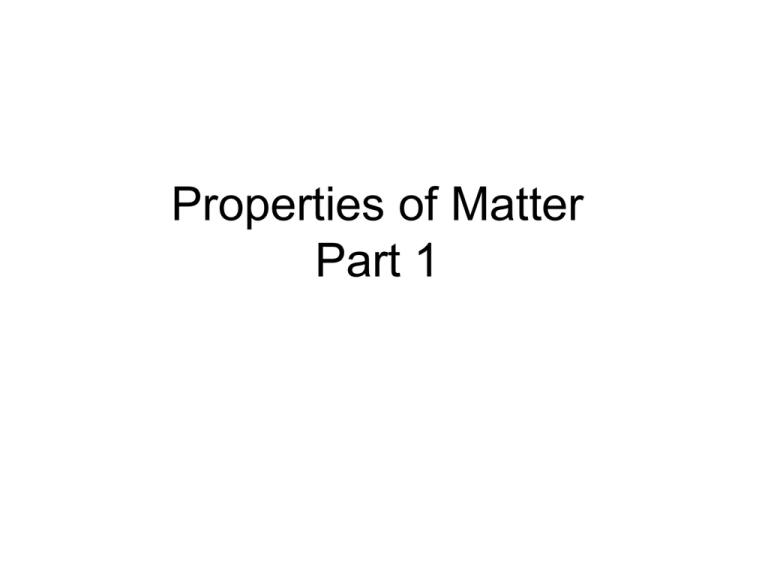
Properties of Matter Part 1 Cues • • • • Matter Volume Molecule Nucleus matter • Anything that has mass and takes up space is matter volume • The amount of space an object takes up • Another word for volume is capacity What are two properties of matter? • All matter has mass and takes up space. All matter is made of ATOMS • The smallest particle that can still be identified as the matter it came from is an atom molecule This is a DNA molecule • A molecule is made up to two or more atoms joined together. • Water is a molecule made of two hydrogen atoms and one oxygen atom. nucleus • The dense area in the center of an atom. • Inside the nucleus of every atom are smaller particles called protons, electrons, and neutrons. What is an atom and what are its parts? What is an atom and what are its parts? An atom is the smallest particle of matter that still behaves like the matter it came from. An atom is made of protons, neutrons, and electrons. Atoms and Molecules are always in motion Assignment • Draw an atom and label its parts in your notebook. And answer questions 1-5 on page 19. Properties of Matter Part 2 Cues • • • • • • Matter can be Pure Substances Elements Compounds Mixtures Comparing Compounds and Mixtures Matter can be • Matter can be pure, or it can be two or more substances mixed together. Most substances you see around you are mixed however you cannot always tell. – For instance, the air you are breathing is a combination of several substances. Pure Substances • A substance is considered pure if it contains only a single type of atom, such as gold, or a single combination of atoms that are bonded together such as a water molecule. element • Matter that is made of only one kind of atom is an element. • Carbon, hydrogen, and oxygen are all elements. • The picture is of the element zinc in hydrogen chloride. Zinc + HCL periodic table • Scientists use the periodic table to organize elements. • Each element has its own special place on the table. • The places are decided by the characteristics of the element. How are the elements arranged in the periodic table? • Elements are arranged in order by their atomic number • The atomic number is the number of protons in the nucleus Compounds • Are substances that consist of two or more different types of atoms bonded together. Mixtures • A mixture is a combination of different substances that remain the same in dividual substances and can be separated by physical means. – For example, if you mix apples, oranges, and bananas to make a fruit salad, you do not change the different fruits into a new kind of fruit Comparing Mixtures and Compounds • Although mixtures and compounds seem similar they are very different. – Substances in mixtures remain the same substances. Compounds are new substances formed by atoms that bond together – Mixtures can be separated by physical means, however compounds can be separated by breaking the bonds between atoms. Changes in Matter Cues • • • • • • Physical Properties Physical Changes Other Physical Changes Chemical Properties and Changes Combustibility Conservation of Matter Physical Properties—describe matter • Melting and boiling point are physical properties (the temperature at which a substance melts or boils) • State of matter is also a physical property (solid, liquid, gas) • Density is a physical property • Density is a measure of how closely packed an object’s atoms are • http://www.harcourtschool.com/activity/hotplate/i ndex.html Physical change-a change in state • The substance is still the same substance • Form changes but chemical makeup doesn’t Ice changes to water—water changes to ice, frozen water is still water Water changes to steam, a gas, when it is heated to its boiling point,water vapor condenses to form a liquid Other Physical Changes • • • • • • • Breaking Crushing Cutting Bending Melting Freezing Boiling • Can happen naturally • People can cause changes – Water evaporating – Rain falling and causing pufflrd – People cause change • Recycling paper • Recycling metal Chemical Properties and Changes • Chemical changes change the chemical nature and properties of substances to form new substances – A match burns – Two substances mix together turn a color different from either of them – Toasting marshmallows • Melt it—physical change • Burn it—chemical change Combustibility-a measure of how easily a substance will burn, or combine rapidly with oxygen • Corrosion of metal—when iron combines with oxygen in the air, rust forms • Gas bubbles—hydrogen peroxide on a cut • A change in color--fireworks Conservation of Matter • Chemical changes don’t make new matter • The total mass of the products that form equals the total mass of the substances that react.
